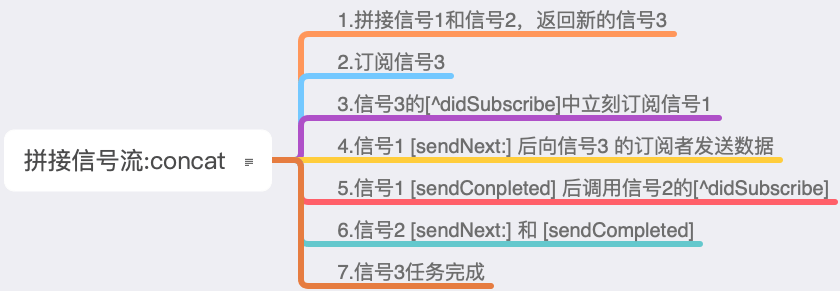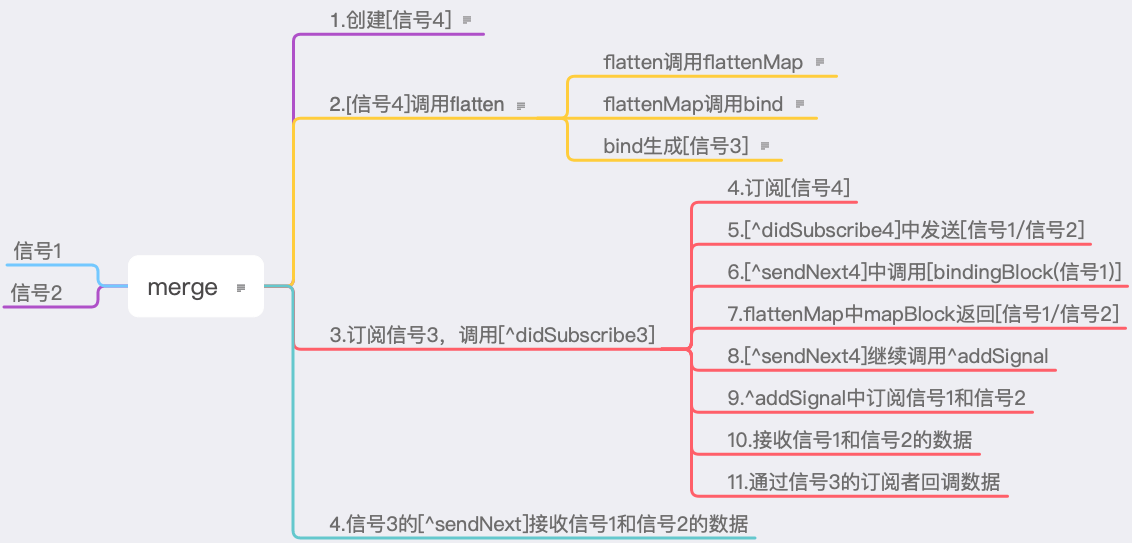前言 项目中往往有多个信号在执行任务,而信号之间通常要按一定的方式或顺序进行组合。比如:
先要用户登录成功才能加载通讯录;
请求头像和用户信息都完成后才刷新详情页。
RAC 针对诸如这些场景,设计了一套实用的API供我们组合信号:
concat 1 2 /// Subscribes to `signal ` when the source signal completes.signal RAC_WARN_UNUSED_RESULT;
作用: 拼接信号流,将信号1与信号2拼接成新的信号,信号1状态为Completed时才开始执行信号2中的任务。无论信号1和信号2谁先发送数据,新信号的订阅者最终都只会按信号1先信号2后的顺序收到回调。
#示例1:
1 2 3 4 5 6 7 8 9 10 11 12 13 14 15 16 17 18 19 20 21 22 23 24 25 - (void)concat {RACSignal *signal1 = [RACSignal createSignal:^RACDisposable *(id<RACSubscriber > subscriber) {NSLog (@"+++call signal1 block" );"1.1" ];RACScheduler mainThreadScheduler] afterDelay:2 schedule:^{"1.2" ];RACSignal *signal2 = [RACSignal createSignal:^RACDisposable *(id<RACSubscriber > subscriber) {NSLog (@"+++call signal2 block" );"2.1" ];RACScheduler mainThreadScheduler] afterDelay:2 schedule:^{"2.2" ];RACSignal *signal3 = [signal1 concat:signal2];NSLog (@"+++++received data:%@" ,x);
日志:
1 2 3 4 5 6 +++call signal1 block data :1.1 data :1.2 call signal2 block data :2.1 data :2.2
说明:
1.信号1和信号2发送几次数据,信号3订阅者就收到几次数据;
2.信号3订阅者收到数据的顺序是确定的,按照拼接时的顺序来:信号1先,信号2后;
3.concat类似于NSOperation的依赖关系,信号2依赖信号1,所以信号2要知道信号1的状态;
4.信号1在发送完数据之后记得sendCompleted,否则信号2的^didSubscribe不会触发,也就不会执行任务;
#实现原理:
1 2 3 4 5 6 7 8 9 10 11 12 13 14 15 16 17 18 19 20 21 22 23 24 25 26 27 28 29 30 31 32 33 34 - (RACSignal * )concat :(RACSignal * )signal {return [[RACSignal createSignal :^ (id <RACSubscriber > subscriber ) {RACCompoundDisposable * compoundDisposable = [[RACCompoundDisposable alloc ] init];RACDisposable * sourceDisposable = [self subscribeNext :^ (id x ) {subscriber sendNext :x ];error :^ (NSError *error ) {subscriber sendError :error ];completed :^ {RACDisposable * concattedDisposable = [signal subscribe :subscriber ];compoundDisposable addDisposable :concattedDisposable ];compoundDisposable addDisposable :sourceDisposable ];return compoundDisposable ;setNameWithFormat :@"[%@] -concat: %@" , self .name , signal ];- (RACDisposable * )subscribe :(id < RACSubscriber > )subscriber {NSCParameterAssert (subscriber != nil );... if (self .didSubscribe != NULL ) {RACDisposable * schedulingDisposable = [RACScheduler .subscriptionScheduler schedule :^ {RACDisposable * innerDisposable = self .didSubscribe (subscriber );disposable addDisposable :innerDisposable];disposable addDisposable :schedulingDisposable ];return disposable ;
代码中有注释,具体整理如下:
then 1 2 3 4 5 6 7 8 9 10 void ))block RAC_WARN_UNUSED_RESULT;
作用: 先执行信号1但过滤掉信号1的数据,再执行信号2的任务并获取其发送的数据。
#示例2:
1 2 3 4 5 6 7 8 9 10 11 12 13 14 15 16 17 18 19 20 21 22 23 24 25 26 27 28 29 30 31 32 33 34 35 - (void )then {RACSignal * signal1 = [RACSignal createSignal :^ RACDisposable * (id <RACSubscriber > subscriber ) {NSLog (@"+++call signal1 block" );subscriber sendNext :@"1.1" ];RACScheduler mainThreadScheduler ] afterDelay :2 schedule :^ {subscriber sendNext :@"1.2" ];subscriber sendCompleted ];return nil ;RACSignal * signal2 = [RACSignal createSignal :^ RACDisposable * (id < RACSubscriber > subscriber ) {NSLog (@"+++call signal2 block" );subscriber sendNext :@"2.1" ];RACScheduler mainThreadScheduler ] afterDelay :2 schedule :^ {subscriber sendNext :@"2.2" ];subscriber sendCompleted ];return nil ;RACSignal * signal3 = [signal1 then :^ RACSignal * {NSLog (@"++++call signal3 then" );return signal2 ;signal3 subscribeNext :^ (id x ) {NSLog (@"++++received data:%@" ,x );
日志:
1 2 3 4 5 +++call signal1 block call signal3 then call signal2 block data :2.1 data :2.2
说明:
1.信号1发送的数据自动被过滤掉,信号3订阅者不会收到数据信号1的数据回调;
2.信号2发送几次数据,信号3的订阅者就收到几次数据;
3.信号2总是在信号1完成之后,才会开始执行自己的任务;
#实现原理:
1 2 3 4 5 6 7 8 - (RACSignal *)then :(RACSignal * (^)(void))block {nil );return [[[self ignoreValues] concat:[RACSignal defer:block]] "[%@] -then:" , self .name];
1.先通过ignoreValues对信号1进行了过滤,忽略掉了它的sendNext:事件,只关注其error和completed事件:
1 2 3 4 5 6 7 8 9 10 11 /// Ignores all `next` s from the receiver.// // Returns a signal which only passes through `error` or `completed` events from// the receiver.RAC_WARN_UNUSED_RESULT ;return [[self filter: ^(id _) {return NO ;setNameWithFormat: @"[%@] -ignoreValues" , self .name];
2.再通过[RACSignal defer:block]],将信号2封装到一个新信号中:
1 2 3 4 5 6 7 8 9 10 11 12 void ))block RAC_WARN_UNUSED_RESULT;void ))block {block != NULL);return [[RACSignal createSignal:^(id<RACSubscriber> subscriber) {return [block () subscribe:subscriber];"+defer:" ];
3.最后用concat方法将两个新信号进行拼接,先执行信号1的任务,再开始信号2的任务。
所以,从本质上来说,then最终调用的还是concat~
merge 1 2 3 4 5 6 + (RACSignal <ValueType > * )merge:(id< NSFastEnumeration > )signals RAC_WARN_UNUSED_RESULT ;
作用: 将n个信号整合为新信号x,信号之间不存在依赖关系,任何一个信号发送数据,信号x的订阅者都会收到回调,且遵循FIFO原则,谁先发送数据则订阅者就先收到谁的数据。
#示例3:
1 2 3 4 5 6 7 8 9 10 11 12 13 14 15 16 17 18 19 20 21 22 23 24 25 26 27 28 - (void)merge {RACSignal *signal1 = [RACSignal createSignal:^RACDisposable *(id<RACSubscriber > subscriber) {NSLog (@"+++call signal1 block" );"1.1" ];RACScheduler mainThreadScheduler] afterDelay:2 schedule:^{"1.2" ];RACSignal *signal2 = [RACSignal createSignal:^RACDisposable *(id<RACSubscriber > subscriber) {NSLog (@"+++call signal2 block" );"2.1" ];RACScheduler mainThreadScheduler] afterDelay:2 schedule:^{"2.2" ];RACSignal *signal3 = [RACSignal merge:@[signal1,signal2]];NSLog (@"+++++received data:%@" ,x);
日志:
1 2 3 4 5 6 +++call signal1 block data :1.1 call signal2 block data :2.1 data :1.2 data :2.2
说明:
1.merge将信号1和信号2整合到信号3中,1、2之间不会相互影响;
2.信号1和信号2发送新数据时,信号3都能收到新数据;
#实现原理
从最底层的实现上来讲,merge使用了RAC的-bind:方法,接下来一步步来看:
这里我们调用了merge,将信号1和信号2合并,来看看方法内部具体做了啥:
1 2 3 4 5 6 7 8 9 10 11 12 13 14 15 16 17 18 19 20 + (RACSignal * )merge:(id< NSFastEnumeration > )signals {NSMutableArray * copiedSignals = [[NSMutableArray alloc] init ];for (RACSignal * signal in signals) {return [[[RACSignal ^ RACDisposable * (id< RACSubscriber > subscriber) { for (RACSignal * signal in copiedSignals) {return nil ;"+merge: %@" , copiedSignals];
这里的信号4看上去是一个挺简单的信号,主要作用就是向订阅者发送信号1和信号2。信号4调用了flatten:
1 2 3 4 5 6 7 8 9 10 11 12 13 14 15 16 17 18 19 20 - (__kindof RACStream *)flatten {// 我将此方法的参数命名为 mapBlock 方便后续解释此处代码return [[self flattenMap: ^(id value) {return value;setNameWithFormat: @"[%@] -flatten" , self .name];flattenMap: (__kindof RACStream * (^)(id value))block {class = self .class ;return [[self bind: ^{//bind 的参数为一个block 此block类型为:RACSignalBindBlock (^)(void),即无参数,返回一个RACSignalBindBlock类型的bindingBlockreturn ^(id value, BOOL *stop) {?: [class empty];isKindOfClass: RACStream.class ], @"Value returned from -flattenMap: is not a stream: %@" , stream);return stream;setNameWithFormat: @"[%@] -flattenMap:" , self .name];
可以看到,flatten方法内部最终是调用了bind方法,即信号4调用了bind方法。
1 2 3 4 5 6 7 8 9 10 11 12 13 14 15 16 17 18 19 20 21 22 23 24 25 26 27 28 29 30 31 32 33 34 35 36 37 38 39 40 41 42 43 44 45 46 47 48 49 50 51 52 53 54 55 56 57 58 59 60 61 62 63 64 65 66 67 68 69 70 71 72 73 74 75 76 77 78 79 80 81 82 83 84 85 86 - (RACSignal * )bind :(RACSignalBindBlock (^ )(void ))block {NSCParameterAssert (block != NULL );return [[RACSignal createSignal :^ (id <RACSubscriber > subscriber ) {RACSignalBindBlock bindingBlock = block ();__block volatile int32_t signalCount = 1 ; RACCompoundDisposable * compoundDisposable = [RACCompoundDisposable compoundDisposable ];void (^ completeSignal )(RACDisposable * ) = ^ (RACDisposable *finishedDisposable ) {if (OSAtomicDecrement 32Barrier(& signalCount ) == 0 ) {subscriber sendCompleted ];compoundDisposable dispose ];else {compoundDisposable removeDisposable :finishedDisposable ];void (^ addSignal )(RACSignal * ) = ^ (RACSignal *signal ) {OSAtomicIncrement 32Barrier(& signalCount );RACSerialDisposable * selfDisposable = [[RACSerialDisposable alloc ] init];compoundDisposable addDisposable :selfDisposable ];RACDisposable * disposable = [signal subscribeNext :^ (id x ) { subscriber sendNext :x ];error :^ (NSError *error ) {compoundDisposable dispose ];subscriber sendError :error ];completed :^ {autoreleasepool {completeSignal (selfDisposable );selfDisposable .disposable = disposable ;autoreleasepool {RACSerialDisposable * selfDisposable = [[RACSerialDisposable alloc ] init];compoundDisposable addDisposable :selfDisposable ];RACDisposable * bindingDisposable = [self subscribeNext :^ (id x ) {if (compoundDisposable .disposed ) return ;BOOL stop = NO ;id signal = bindingBlock (x , & stop );autoreleasepool {if (signal != nil ) addSignal (signal );if (signal == nil || stop ) {selfDisposable dispose ];completeSignal (selfDisposable );error :^ (NSError *error ) {compoundDisposable dispose ];subscriber sendError :error ];completed :^ {autoreleasepool {completeSignal (selfDisposable );selfDisposable .disposable = bindingDisposable ;return compoundDisposable ;setNameWithFormat :@"[%@] -bind:" , self .name ];
bind方法里的代码逻辑,结合我在上面的标注来看:
1.信号4调用bind方法后,bind内部先创建了一个新的信号并沿着调用路径层层往上返回给调用者,最终这个新信号的接收者正是我们在最开始执行”[RACSignal merge:@[signal1,signal2]]”时的signal3,即信号3。在示例3中订阅信号3之后,触发其^didSubscribe3,也就是bind方法内新建信号后面的那个大 block。
2.^didSubscribe3先调用了bind的 block参数,返回了一个bindingBlock备用;
3.紧接着订阅了信号4,从而触发^didSubscribe4;
4.^didSubscribe4通过 for循环将信号1和信号2作为数据发送给订阅者^sendNext4;
5.^sendNext4中调用bindingBlock,其参数为信号4传来的信号1和信号2;
6.bindingBlock内调用了block(value),即回调了flattenMap方法的 mapBlock,最终返回了value(信号1和信号2);
7.^sendNext4继续调用addSignal(信号1/信号2);
8.addSignal()内部实现是订阅传进来的信号,即订阅了信号1和信号2;
9.到这一步bind已经万事俱备,只等接收数据了。当信号1和信号2产生新数据时,^sendNext1/^sendNext2会自动触发;
10.^sendNext1/^sendNext2内通过^didSubscribe3将数据回调给订阅者,因为^didSubscribe3本身代表的是信号3的订阅,所以信号1和信号2的数据最终传递给了信号3的订阅者,即我们在示例3中定义好的 block 中;
小结: 以上就是merge方法的具体实现,简单来说就是merge操作得到的新信号,通过bind方法在内部订阅了被merge的子信号;子信号产生一份数据时新信号就会收到一份新数据。所以想要更好的理解merge方法,就要先理解bind方法。
附赠我用思维导图整理的merge实现:
zip 1 2 3 4 5 6 7 8 9 10 11 + (RACSignal <RACTuple *> * )zip:(id< NSFastEnumeration > )signals RAC_WARN_UNUSED_RESULT ;
作用: 将n个信号打包进一个新信号中,当所有子信号都sendNext之后,新信号将接收到的数据组合在一个元组中,值在元组中的排序按照打包信号时的顺序来。
#示例4:
1 2 3 4 5 6 7 8 9 10 11 12 13 14 15 16 17 18 19 20 21 22 23 24 25 26 27 28 29 - (void)zip {RACSignal *signal1 = [RACSignal createSignal:^RACDisposable *(id<RACSubscriber > subscriber) {NSLog (@"+++call signal1 block" );"1" ];RACSignal *signal2 = [RACSignal createSignal:^RACDisposable *(id<RACSubscriber > subscriber) {NSLog (@"+++call signal2 block" );RACScheduler mainThreadScheduler] afterDelay:1 schedule:^{"2.1" ];RACScheduler mainThreadScheduler] afterDelay:2 schedule:^{"2.2" ];RACSignal *signal3 = [RACSignal zip:@[signal1,signal2]];NSLog (@"+++++received data:%@" ,x);
日志:
1 2 3 4 5 6 +++call signal1 block call signal2 block data :<RACTuple: 0x7ff33e4bbab0 > ( 1 ,"2.1" )
说明:
1.信号3的订阅者要在组合中的信号都sendNext:之后才会收到回调的元组;
2.信号3元组中数据的顺序与组合时信号的顺序排列一致;
3.信号3的订阅者是一次性的,收到一次数据后,不论源信号再发送几次数据,它都不再接收。
zip可用来整合网络请求,例如当需要同时发送N个请求,只有这N个请求都成功后,才将这N个的结果整合起来继续往下处理。
combineLatest 1 2 3 4 5 6 7 8 9 10 11 12 + (RACSignal <RACTuple *> * )combineLatest:(id< NSFastEnumeration > )signals RAC_WARN_UNUSED_RESULT ;
作用: 将多个信号的最新值组合到新信号的一个元组中,直到所有的信号都sendNext之后,新信号的订阅者才能收到此元组。
#示例5:
1 2 3 4 5 6 7 8 9 10 11 12 13 14 15 16 17 18 19 20 21 22 23 24 25 26 27 28 29 30 31 32 33 34 - (void)combineLatest {RACSignal *signal1 = [RACSignal createSignal:^RACDisposable *(id<RACSubscriber > subscriber) {NSLog (@"+++call signal1 block" );"1" ];RACSignal *signal2 = [RACSignal createSignal:^RACDisposable *(id<RACSubscriber > subscriber) {NSLog (@"+++call signal2 block" );"2.1" ];RACScheduler mainThreadScheduler] afterDelay:2 schedule:^{"2.2" ];RACSignal *signal3 = [RACSignal createSignal:^RACDisposable *(id<RACSubscriber > subscriber) {NSLog (@"+++call signal3 block" );"3.1" ];RACScheduler mainThreadScheduler] afterDelay:2 schedule:^{"3.2" ];RACSignal *signal4 = [RACSignal combineLatest:@[signal1,signal2,signal3]];NSLog (@"+++++received data:%@" ,x);
日志:
1 2 3 4 5 6 7 8 9 10 11 12 13 14 15 16 17 18 02 :30 :08.894 +++call signal1 block 02 :30 :08.895 +++call signal2 block 02 :30 :08.895 +++call signal3 block 02 :30 :08.896 +++++received data :<RACTuple: 0x7ff33e49e300 > ( 1 ,"2.1" ,"3.1" ) 02 :30 :10.895 +++++received data :<RACTuple: 0x7ff33e4db8d0 > ( 1 ,"2.2" ,"3.1" ) 02 :30 :11.094 +++++received data :<RACTuple: 0x7ff33e6e79f0 > ( 1 ,"2.2" ,"3.2" )
这里需要说明的是:
1.信号4订阅者的元组中数据的顺序,是按照组合时的顺序来的;
2.信号4的订阅者第一次触发是在所有信号都发送了一遍sendNext:之后;
3.之后如果再有某个信号sendNext:,信号4都会再次触发并返回最新值组成的元组,这是它与zip的最大不同;
结束语 以上就是RAC中几种常用组合信号的方法,可以根据业务需求任意组合操作,很强大、方便。
相关参考:
#©RAC-Github

